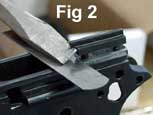

I have a feeler gauge I am using to protect the frame from damage. I just bought an cheap feeler gauge set from a auto parts store, and cut off one of the thicker ones for this job. I usually carefully use a large screwdriver to exert upward pressure on ejector, as in the first picture. Now ensure that after ejector starts to move, you stop and pry it up from the center, or you might bend the two legs that secure it.

Now if you have a stock mil-spec ejector, without the protrusion out front it is a little more difficult to remove easily, so I also took one of these feeler gauges and sharpened the rounded end and will wedge it under the Ejector and hammer it up. With padded vise jaws you can also clamp your vise on the ejector and with a nylon faced hammer tap off frame. ejector1s.jpg - 10800 Bytes If you plan on replacing the mil-spec ejector with an extended one, use Vise-grips to remove. I usually attempt to put a slight backwards angle on ejectors, so that the brass hits the bottom part of the ejector arm, the part closest to the frame, first. Refer to

and (Fig-4)

on ejector shaping. Once you have the backwards angle filed, next put another slight angle on the ejector so that the brass hits the left side of the arm first, (as seen from the top) refer to (Fig-5).

I do all my ejector shaping with a file while the ejector is in my padded bench vise, although if carefull it can be done while it is still attached to the pistol frame. Once you have shaped your ejector, the next important step is to notch the forward leg so the 1/16 pin will capture it. Place ejector in frame and tap it down with a nylon headed hammer and ensure it is completely flush with the frame. Next go ahead and lay frame down on your bench sideways. Place 1/16 punch in the frame and mark the ejector leg;

I usually do it from both sides. Carefully remove, and notch the leg with a small round file where the punch has marked it. I usually try to file the the ejector leg a little high. Dont go too far; take a few strokes and place back in frame until you can put a 1/16 punch all the way through frame. Next ensure Ejector does not drag when slide is on the frame. If it does, dress down the ejector where dragging, with a file.
After ensuring there is no drag, and that a 1/16 punch can be inserted all the way through the frame, meaning that you notched the ejector properly. Now remove ejector and coat both legs with blue loctite and replace in frame. I usually like using a solid pin instead of the roll pins which many use; I have seen too many of the roll pins deform when you only get about half of the pin in the frame, and sometimes they're to tight to get out. I make my ejector pins from solid 1/16 stock, and blue loctite it in. Well thats how it is done in my shop. Good luck,